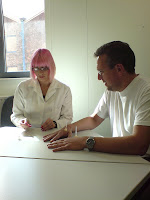 The biggest problem with acupuncture research is that it is very difficult to create a convincing placebo treatment for the control group to undergo. If participants can tell whether they have received acupuncture or not, the results of the trial are pretty much worthless as evidence. Similarly, it is important that the practitioner too should be unable to tell whether they have given real acupuncture or not. Many different sham treatments have been tried, but none had been particularly convincing until, in recent years, some dummy needles have been developed that do allow double-blinding (Park et al, 2002, White et al 2003).
The biggest problem with acupuncture research is that it is very difficult to create a convincing placebo treatment for the control group to undergo. If participants can tell whether they have received acupuncture or not, the results of the trial are pretty much worthless as evidence. Similarly, it is important that the practitioner too should be unable to tell whether they have given real acupuncture or not. Many different sham treatments have been tried, but none had been particularly convincing until, in recent years, some dummy needles have been developed that do allow double-blinding (Park et al, 2002, White et al 2003). I wanted to see these needles for myself, so I contacted Dong Bang Acuprime, who kindly sent me a few samples of their Park Sham Device to try out. They have helped develop and test these fake needles in order to improve the evidence base for acupuncture, and I really admire them for doing so. Few CAM enthusiasts are willing to put their beliefs to the test like this.
So here I am with my colleague Nikola Bridges, who is about to insert two needles into the plastic sleeves you can see attached to my hands with sticky pads. One needle is real, one sham, but at this point neither of us know which is which. When Nikola presses down on the needles, the real one will penetrate my skin, while the sham one will slide inside its handle, giving the appearance of penetration without actually going in. If the placebo is truly convincing, neither of us will be able to tell which is which until I turn my hands over, at which point the fake will fall out onto the table.
To see what happened next, watch this video before scrolling down to read on...
All in all, I was a little disappointed. The fake needle telescoped very easily while the real one took a lot of tapping to get down to the same extent, so it was fairly clear to Nikola which one was real. I couldn't feel much difference at first, after the initial insertion, but it was pretty obvious which one was real once it started to go in properly. The real needle also left a tiny but noticeable mark on my skin, and was obviously longer than the fake one when we took them out again. There is also still (a few hours later) a hint of pain in my left hand. Sadly, I have to conclude that the placebo was not 100% convincing.
Let's not be too negative, however. There were many flaws with my little experiment. In a real study, you would not have the same person experiencing both types of needle at the same time, so the contrast between needles would not be so apparent. If the acupoints were out of sight, such as on the patient's back, it would be harder (for the patient, at least) to tell what was going on. I am not sure if it is important that Nikola is NOT an acupuncturist and had not had any chance to practice the insertions (she is a neuroscientist and has plenty of experience with needles, just not this kind) but I think it would probably be even more obvious to an experienced needler which one was which. We were both a bit nervous, though! Maybe two single confident thrusts might have been harder to discriminate?
My conclusion is that it is very hard to maintain double-blindness in acupuncture studies, even with the best sham needles. I think it may be possible to do a good double-blind study with these, but both patient and practitioner would have to be very self-disciplined, to resist the temptation to break the blinding. Sadly, my experience suggests that it would be very easy to succumb.
References
Park, J., White, A., Stevinson, C., Ernst, E. & James, M. (2002). Validating a new non-penetrating sham acupuncture device: two randomised controlled trials. Acupuncture In Medicine, 20, 168-174.
White, P., Lewith, G., Hopwood, V. & Prescott, P. (2003). The placebo needle, is it a valid and convincing placebo for use in acupuncture trials? A randomised, single-blind, cross-over pilot trial. Pain, 106, 401–409.


5 comments:
A really nice example of the self-experimentation genre. Not quite Barry J. Marshall but very instructive and thoughtfully interpreted; thank you.
Hi, do you know, by any chance how much these Park Sham needles cost?
Thanks!
Great and useful post.An acupuncture needle is a stainless steel needle that is slightly thicker than a human hair. Acupuncture needles are inserted through the skin at specific points on the body to control pain and other symptoms.
Cupping Sets
Great and useful post.An acupuncture needle is a stainless steel needle that is slightly thicker than a human hair. Acupuncture needles are inserted through the skin at specific points on the body to control pain and other symptoms.
Cupping Sets
Nice Post!!!
Igaku Needles Pvt. Ltd. Is leading named in manufacturing, supplying and exporting a wide range surgical needles in India. Igaku is leading Stainless Steel Cannula Needle Manufacturer in India.
Post a Comment